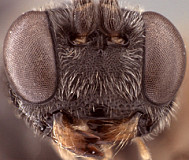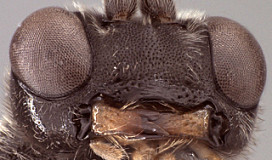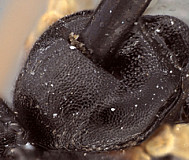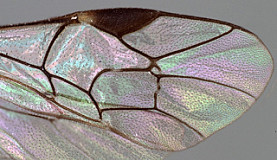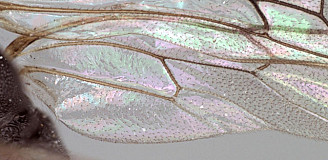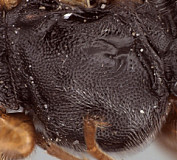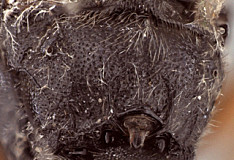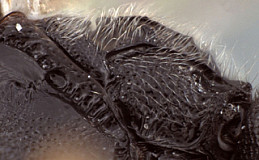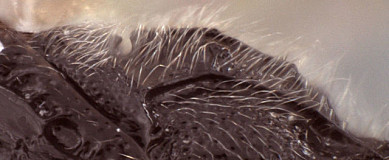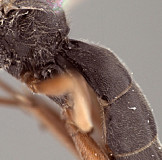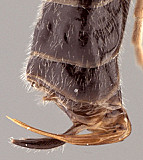Femaie with inner eye margins only weakly converging ventrally (Fig. 1) if at all. Clypeus (Figs 1, 2) with a few long, scattered, anterior-ventrally directed setae, otherwise largely bare but with dorsal half covered by long, ventrally-directed facial setae; densely punctate to finely granular dorsally, weakly rugulose to polished over at least ventral 0.5; ventral margin blunt, varying among species from evenly convex to weakly truncate; epistomal sulcus distinctly impressed throughout. Face densely sculptured: finely granular; frons densely, coarsely punctate to shagreened, vertex densely but more finely punctate; frons and vertex densely setose. Malar space short, varying from virtually absent to almost half basal width of mandible; malar sulcus absent. Mandible (Fig. 2) with ventral tooth almost twice length of dorsal tooth; with very distinct basal, somewhat transverse, pit-like depression. Maxillary palps less than height of head. Female antenna less than half length of body; male antenna nearly as long as body. Hypostomal carina meeting occipital carina distinctly dorsad base of mandible; occipital carina complete. Epicnemial carina (Fig. 6) usually extending to anterior margin of mesopleuron but sometimes very weakly developed dorsally and appearing to end distant from anterior margin (e. g. some specimens of
G. punctatus). Notaulus (Fig. 3) varying from a shallow, anterior depression confined largely to anterior declivity to complete or nearly so as in
G. tomostethi. Groove between propodeum and metapleuron distinctly u-shaped (Figs 8, 9); broad, u-shaped groove mid-dorsally between propodeum and metanotum readily visible in lateral view; pleural carina well-developed ventrally, extending to level of propodeal spiracle; propodeum (Fig. 7) with posterior transverse carina usually well developed, anterior transverse carinae absent or poorly developed, areola absent or rarely very small, usually indicated posteriorly but effaced anteriorly; lateral and narrowly separated median longitudinal carinae usually present, though median carinae sometimes effaced. Apical margin of mid tibia expanded into a distinct tooth similar to that of fore leg only in some species; apical comb on posterior side of hind tibia present or absent but not particularly well-developed when present; posterior hind tibial spur at least 6x longer than maximum width at base; tarsal claws on fore and hind legs pectinate in at least one species, not pectinate in others. Fore wing (Fig. 4) areolet present or absent; stigma relatively broad with Rs+2r arising near midpoint of stigma. Hind wing (Fig. 5) with first abscissa of CU1 much longer than 1cu-a. T1 (Fig. 10) distinctly broadening from base to apex in female, more slender and gradually broadening in male; dorsal carinae sometimes poorly indicated (Fig. 10) but usually distinctly elevated basally, not extending much beyond level of spiracle, never reaching apex; basal depression at dorsal tendon attachment shallow but appearing deeper because of inflated basal portion of T1; dorsal-lateral carina usually present, rarely absent between spiracle and apex of T1; glymma large, deep, extending to depression at base of dorsal tendon attachment. S1 very short in
G. tomostethi and
G. punctulatus, extending about half distance to spiracle. T2 thyridium absent; laterotergites of T2 and T3 separated by creases from median tergite. Ovipositor (Fig. 12) shallowly and evenly upcurved throughout; apical half uniformly needle-like, abruptly narrowing from broader basal bulb; without dorsal, subapical notch. Ovipositor sheath sparsely setose and narrowly sickle-shaped, a little more curved than ovipositor.
This description is based largely on specimens of G. tomostethi, G. punctatus, and G. punctulatus in the AEI and CNC.
2.
Glyptorhaestus mandibles...
Glyptorhaestus mandibles
↰
↴
3.
Glyptorhaestus mesoscutum sho...
Glyptorhaestus mesoscutum showing notauli
↰
↴
4.
Glyptorhaestus fore wing...
Glyptorhaestus fore wing
↰
↴
5.
Glyptorhaestus hind wing...
Glyptorhaestus hind wing
↰
↴
6.
Glyptorhaestus mesopleuron ...
Glyptorhaestus mesopleuron showing epicnemial carina
↰
↴
7.Glyptorhaestus Propodeum
8.
Glyptorhaestus u-shaped groove between pro...
Glyptorhaestus u-shaped groove between propodeum and metapleuron
↰
↴
9.
Glyptorhaestus u-shaped groove ...
Glyptorhaestus u-shaped groove between propodeum laterally
↰
↴
10.
Glyptorhaestus T1...
Glyptorhaestus T1
↰
↴
11.
Glypt...
Glyptorhaestus metasoma dorsal view
↰
↴
12.
Glyptorhaestus ovipo...
Glyptorhaestus ovipositor
↰
↴

